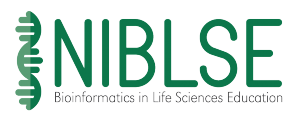Resources
Using computational molecular modeling software to demonstrate how DNA mutations cause phenotypes
Author(s): Tara Phelps-Durr
Radford University
1416 total view(s), 309 download(s)
Description
From the abstract:
Students require a deep understanding of the central dogma before they can understand complex topics such as evolution and biochemical disorders. However, getting undergraduate biology students to apply higher-order thinking skills to the central dogma is a challenge. Students remember and regurgitate the molecular details of transcription and translation but if asked to apply these details, such as how a DNA mutation might affect phenotype, it becomes clear that most students do not deeply understand the central dogma. This lesson is a five-week series of laboratory activities designed to help students transition from applying lower order thinking skills to the central dogma to applying higher-order thinking skills. Over five weeks, students explore the phenotype of Arabidopsis asymmetric leaves 1 (as1) and as2 mutants. Students isolate DNA from wild-type and mutant plants and determine the sequence of the AS1 and AS2 alleles. Students use the DNA sequence data to determine the mutant protein amino acid sequences. They submit the mutant and wild-type protein sequences to a free online server and obtain three-dimensional (3-D) models of the wild-type and mutant proteins. They use free software to analyze and compare the 3-D models to determine the structural differences between the wild-type and mutant proteins. These computer-generated models can be 3-D printed allowing students to better visualize the protein structure. The overall goal is to use student-centered laboratory activities to demonstrate the relationship between DNA sequence, protein structure/function, and phenotype.
Citation:
Phelps-Durr, T.L. 2016. Using computational molecular modeling software to demonstrate how DNA mutations cause phenotypes. CourseSource. https://doi.org/10.24918/cs.2016.16
Cite this work
Researchers should cite this work as follows:
- Phelps-Durr, T. (2019). Using computational molecular modeling software to demonstrate how DNA mutations cause phenotypes. Network for Integrating Bioinformatics into Life Sciences Education, QUBES Educational Resources. doi:10.25334/Q42F1T
